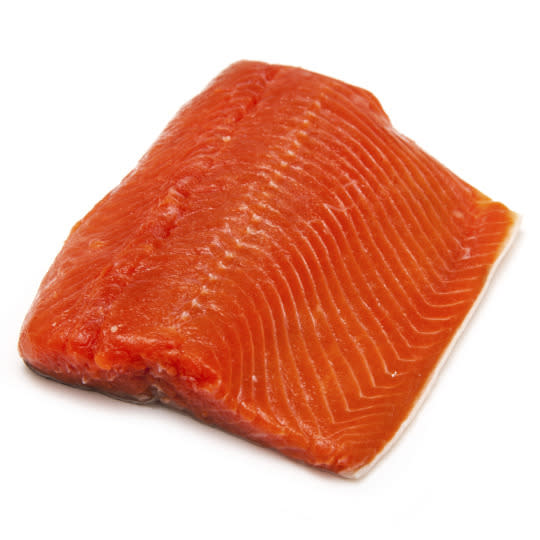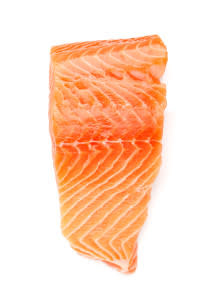Why You Should Eat More Wild Caught Salmon

(Photo: Corbis Images)
When was the last time you had salmon?
I eat this tasty fish at least once a week, partly because of its versatile flavor, and partly because it’s a supreme source of several rare performance-boosting nutrients. It’s also easy to cook. You can even eat it raw if you buy the good stuff.
And it’s worth it to buy the good stuff, because like beef, not all salmon is created equal. A lot of salmon’s flavor, fattiness, and nutrient profile depends on where and how it spent its life. Let’s take a deeper dive (no pun intended) into the world of salmon. You’ll learn about all the powerful compounds in this delicious fish, how to choose the best salmon, and how to cook it perfectly with a Bulletproof recipe.
Astaxanthin: nature’s anti-aging food coloring
Color says a lot about food, and salmon is no exception. Look at the two pictures below:

The salmon above is wild-caught Alaskan sockeye. The salmon below is farmed.

The sockeye is a robust, satisfying red. That’s what salmon should look like. The farmed variety doesn’t even compare. It’s so pale – you can tell that the fish it came from was sickly.
Related: 5 Types Of Fish You Should Avoid Eating
The difference in color is thanks to astaxanthin, a bright red molecule found in algae, plankton, and krill. This stuff is powerful. Astaxanthin:
Protects your mitochondria by strengthening their cell membranes keeping out damaging oxygen species.
Increases strength endurance by more than 50% when used as a supplement, according to one study. The study was sponsored by an astaxanthin supplement company, so take the results with a grain of salt. That said, the study was also randomized and placebo-controlled, and it had a good number of participants.
Wild salmon get plenty of astaxanthin from their diets – especially sockeye salmon, which almost exclusively eat astaxanthin-rich plankton. Farmed salmon eat food pellets that don’t contain natural astaxanthin, so farmers add in a synthetic version. Most commercial astaxanthin comes from petrochemicals like coal, and it’s not chemically identical to natural astaxanthin.
Other components of fish feed include fish meal and fish oils that are at risk for dioxin and mercury contamination. In recent years, farmers have tried to decrease heavy metal contamination by replacing fish meal/oil with soy and corn protein and vegetable oil, but salmon aren’t meant to eat soy and corn, so their meat quality plummets (see the pictures above), and farmers often have to administer antibiotics to keep them healthy; trace amounts make it into the salmon meat you eat. The vegetable oils also decrease omega-3 fat content in salmon meat and can introduce mold toxins to salmon. Gross.
TLDR: Do not eat farmed salmon. Stick to wild-caught varieties.
Related: 50 Foods the Healthiest People Always Stock in Their Kitchens
Mercury content in salmon
That look at fish feed was bleak. Here’s some good news: the FDA and EPA have both been studying mercury contamination in fish, and wild-caught salmon has consistently been at very low risk of mercury contamination. They deem salmon safe to eat multiple times per week.
What’s the best kind of wild salmon?
It depends on what nutrients you want.
Sockeye salmon has the most astaxanthin, cholesterol, and vitamin D by far, because sockeyes have an unusual diet of almost exclusively plankton . Their unique eating habits make them extraordinarily difficult to farm, so sockeye salmon is basically always wild. It’s also high in omega-3s. Sockeye has a strong flavor. It’s great for you, and it’s very tasty smoked (more on smoked salmon in a minute).
Chinook (king) salmon, on the other hand, has nearly twice as many omega-3s as any other salmon species does. Chinooks favor deep, cold water. The extra omega-3s keep them warm – the fat stays liquid in their system and prevents them from freezing. Unlike sockeye salmon, Chinook salmon can be farmed, so always check your source to make sure you’re getting a wild-caught fish.
Pacific coho salmon is another strong option. It has the third-highest fat content of salmon, coming in behind Chinook and sockeye. Coho also has respectable vitamin D content and a solid dose of omega-3s .
Sockeye, Chinook, and coho salmon are all excellent choices, as long as they’re wild-caught. Each has a specific taste; see which one you prefer.
How to cook your salmon
Smoked salmon tastes wonderful, and it’s fairly Bulletproof. The downside is that smoking meat produces histamine, which can cause inflammation if you’re sensitive to it. Try some smoked salmon and see how it makes you feel. And opt for cold-smoked salmon if you can find it. The lower temperature better preserves the omega-3s.
If you buy your salmon raw, try out this recipe from Bulletproof: The Cookbook. Its simplicity lets the rich flavor of the fish come out, and the acid from the lemon juice balances out the fat.
Perfect Parchment-Baked Salmon
Serves 2
Salmon is one of the perfect superfoods if you cook it just right. If you go too long, it’s no bueno. This recipe takes the guesswork out, so it’s a can’t-miss way to get your omega-3s.
2 center-cut wild salmon fillets (8 ounces each)
1 teaspoon Bulletproof Brain Octane oil (or MCT or coconut oil)
Sea salt
1 tablespoon grass-fed unsalted butter
1 tablespoon minced fresh herbs (such as chives, parsley, or dill)
Lemon wedges, for serving1)
Preheat the oven to 320°F.2) Place the salmon on a piece of parchment paper on a baking sheet. Rub the fillets with Brain Octane oil,season with sea salt, and top with the butter.3) Wrap the parchment around the fish, folding seams and tucking them to ensure steam does not escape.4) Bake until fish is medium-rare, about 18 minutes. Sprinkle with the herbs and a squeeze of lemon.
Enjoy!
Read This Next: The Best and Worst Fish For Your Health

